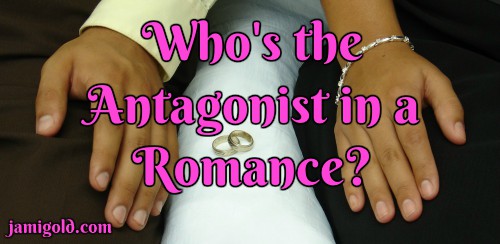Thursday Thoughts: The Antagonist Role in Romance

As I mentioned last month, my current burnout level means that I’m trying to reduce the amount of time this blog takes while still ensuring that I’m sharing good stuff with you all. *smile*
If you missed the announcement, my current blogging schedule is:
- Tuesdays: New blog content like usual.
- Thursdays: Sharing other content:
- guest posts,
- rerunning older posts,
- favorite post I discovered online that week,
- linking to all the writing-related posts I tweeted about that week,
- etc., etc.
Today, I’m sharing a post by Diana Hurwitz from the Blood Red Pencil blog that made me think about the nature of antagonists in romance novels. (And read to the end of this post to catch a few announcements of book promotions you might like. *smile*)
What Are Antagonists?
I’ve written before about the different types of antagonists—from sidekicks and mentors to ticking clocks and and traffic jams. And last year, Kristen Lamb shared her many insights into antagonists with a series of guest posts here, including one that introduced the idea of a scene antagonist giving us the conflict we need in every scene. Yet, antagonists can still be tricky.
Who or what is the antagonist when there's no “bad guy”—like in a romance? Click To TweetIn some genres, it’s easy to identify who the antagonist of the story is. Genres such as thrillers or mysteries feature the villain-style of antagonists, obvious “bad guys” threatening to blow up a city or murder an innocent.
Stories in the survival genre feature a similarly obvious “overcome nature” type of antagonist. The protagonist must escape storms, earthquakes, jungles, etc., and the obstacles in the way all come from harshness of the natural environment.
However, in other genres, the antagonist might not be as obvious. There might not be a villain or bad guy, and what the protagonist is trying to overcome might be more subtle. Often, the antagonist can be tricky to identify in the romance genre, with its complex combination of internal conflict, external conflict, and conflict between the couple.
Antagonists in Romance
While internal conflict from false beliefs is expected in romance stories, given the character-focused nature of the genre, external conflict can be complicated. External conflict can be driven by something or someone internal or external to the relationship.
Some subgenres of romance—such as the paranormal romance I write—include bad guys for that conflict external to the relationship, but for the most part, romance doesn’t have “big bad villains.” Even in my paranormal romance stories, the villain often doesn’t come into the picture until the end, so other antagonistic forces have to create conflict until the big finale.
Without villains, we might rely on conflict internal to the relationship. That’s why it’s common for the couple to act as each other’s antagonists, as they each need what only the other one can provide (love, acceptance, respect, etc.).
However, if we rely too much on the couple being each other’s antagonists, we might accidentally create an unhealthy relationship, as Bran L. Ayres pointed out in their recent guest post. Or we can simply create a couple that’s not believable because readers don’t understand what they see in each other.
Those conflicts between the couple have to balance on a thin line:
- enough conflict to sustain a story
- limited conflict to keep the couple a good match
In my post about that balance, I shared three techniques for how we can find the right amount of conflict and compatibility between the couple. Now with Diana’s post, we get to look at external romance antagonists from a different perspective.
What’s Keeping the Couple Apart?
Romance stories come in all “flavors” of conflict, angst, and obstacles. While some include bad guys, enemies-to-lovers tropes, or other obvious problems, other romance stories are less angsty, more sweet, or on a smaller, more-human scale.
How can we avoid creating too much conflict between a couple in a romance? Click To TweetMaybe the couple acknowledges their mutual attraction right away. Maybe they even act on it, starting a relationship from the get-go.
In stories like that, it can be especially difficult to identify an antagonist, but Diana points out that essentially, antagonistic forces in romance are whatever keeps the couple apart.
In any genre, anything that stands in the way of the protagonist getting what they want (or think they want) is an antagonist. In the romance genre, even if the characters don’t yet see themselves as wanting a relationship, readers know that’s the ultimate goal (the promise of the genre), so anything that keeps the couple apart is an antagonist as far as readers—and the story itself—are concerned.
The Right Balance: Any Antagonistic Force for Any Story
The better we understand what’s keeping the couple apart, the more we can develop and balance our story’s conflict to the appropriate level. As needed, we can cut back or emphasize the “keeping them apart” obstacles for our story.
For example, for the same antagonist from Diana’s post of “a disapproving family member keeps them apart,” we might have:
- a meddling mother who keeps trying to set up her daughter with that boring son of her coworker —or—
- a wrathful mother who blackmails her daughter’s love interest with faked photos implying an affair.
Either level of antagonist counts as an obstacle and creates conflict, but obviously they’d lead to very different types of stories, with different themes, subtext, and tones. Despite how the second one might feel more dire or larger in scale, there’s no “best” choice, other than what works for our story. Not every story will have, or should have, life-and-death stakes or ooze with melodrama.
Now, check out Diana’s post for 10 ideas for external romance antagonists and see if this helps you brainstorm other obstacles that could keep a couple apart…
The Antagonist Role in Romance — by Diana Hurwitz
With the right level of antagonism, we can explore many different options for external antagonists in a romance—and ensure we’re not creating an unhealthy or implausible relationship, filled with too much conflict between the couple. *smile*
Bonus: Current Book Promotions
The first novel of my Mythos Legacy series, Treasured Claim, is part of several romance bundles, so if you like that story, you might find other books to enjoy in these groups too. (Or if you don’t have Treasured Claim yet, you can grab a copy from one of these bundles.)

Hexed on the Beach
Like supernatural, fantasy, or paranormal stories set on beaches, islands, lakes, etc.? Check out this bundle of 18 books by July 7th!
The Hotter the Better
Want steamy romance? Check out this bundle of 176 books(!) covering every genre of romance by July 31st!
Summer of Love and Magic
Want to get lost in fantastical new worlds and be swept away with romance? Check out this bundle of 36 books by July 31st!
Dragon Deals
Love dragons in your paranormal romance? Starting this Sunday the 8th, check out this bundle of almost 40 books by July 21st!
P.S. And don’t forget to enter my Blogiversary Contest! We’re up to two winners so far, and the more comments we get, the more winners we’ll have.
Do you ever struggle with identifying the antagonist of your scenes or stories? Do you agree that antagonists in romance are anyone or anything in the way of the couple getting together? Have you read—or written—romances with too much or too little conflict? Does it make sense how external conflict sometimes might be more helpful than conflict between the couple?
Pin It
This article helps so much as it was a topic I couldn’t get my head around for a while. I have a preference for romance, too, that the external conflict dominates the third act and the couple are fully gone for one another by then. (Even if this is still a secret.) It’s just frustrating as a reader to get the commitment on the last couple of pages. I like to wallow in it 😀
Hi Jolie,
I’m with you that I want to enjoy the warm fuzzies for a bit. 🙂 Thanks for the comment!
Thanks, it can help if the couple’s jobs appear mutually exclusive.
Hi Claire,
Yes, there’s certainly a lot that can be done with jobs in opposition. I’ve written about forbidden romances before as well, which can cover all sorts of situations and circumstances. 🙂 Thanks for the comment!
[…] No matter what we write, the characters have to be compelling. Not always likeable, but compelling. Donald Maass explores what heroism means today, Brian DeLeonard reboots the mentor trope, Greer Macallister talks about how to write bad characters, and Jami Gold discusses the antagonist role in romance. […]
Hey Jami! It could depend on the reader as well what kind of conflict they can tolerate in romances. Once again, I may be in the minority, because I actually like seeing relationship conflicts between the couple, lol. For example, a couple could struggle with one partner being overprotective in one book, and struggle with another partner being too jealous and possessive in the next book. Sometimes the conflict gets so frustrating that a partner threatens to leave the relationship. I can see why many romance readers would feel little confidence for this couple, but in my mind, real life couples quarrel all the time about issues (and some may also threaten to break up if the issue is not resolved). But I would feel MORE confident about a couple’s relationship if I see them conquer conflict after conflict. My belief is that there will always be times when some interpersonal issue or another will endanger the relationship, and that this is normal. What matters to me is that the couple can handle and get over these hurdles. And even if they can’t solve a problem, they can at least learn to live with those differences without resentment. I’m biased, though, since I learned all these theories from my couple’s therapy course and books on marital counselling. XD So I simply expect conflict to happen from time to time. In fact, I might worry for a couple if they seem to have zero internal problems. They seem so in love… — Read More »
Hi Sieran,
That’s a great point! A couple who doesn’t overcome any conflict can seem vulnerable to breakup when they’re eventually faced with difficulties and struggles. As you said, the idea is to pay attention not to eliminating relationship conflict but making sure it’s dealt with in a healthy way.
Like you alluded to, there’s a big difference in my mind between a couple having unhealthy accusations and behaviors when faced with conflict versus a couple being able to work toward a stronger partnership as part of their overcoming the conflict. So yes, I agree completely! 😀 Thanks for sharing!
[…] If you’re interested in reading more on this subject, author and writing teacher Jami Gold has an excellent article on antagonists in romance fiction here: https://jamigold.com/2018/07/the-antagonist-role-in-romance/ […]